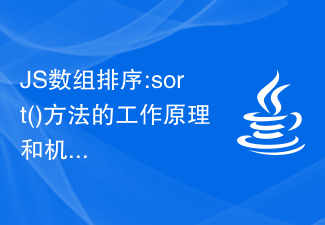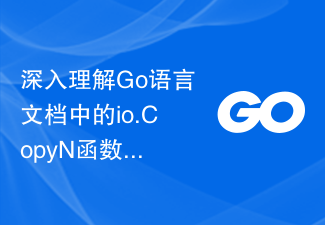
In-depth understanding of Java IO programming experience and suggestions
Java IO (input/output) is a crucial part of Java programming. It provides functions for processing input and output, allowing us to interact with data with the external world. In this article, I will share some experiences and suggestions about Java IO programming to help you deeply understand and use Java IO correctly.
1. Master the basic concepts
Before starting to learn Java IO, there are several basic concepts that need to be mastered. The first is Stream. Stream is the core concept of Java IO. It is a continuous data stream from which data can be read and written. Another important concept is blocking (Blocking) and non-blocking (Non-blocking) IO. Blocking IO means that when a program is reading or writing data, it will be blocked until the data is completely read or written. Non-blocking IO means that the program will not be blocked when reading or writing data, but will return immediately, and may only read part of the data.
2. Understand the classification of IO classes
The Java IO class library provides a wealth of classes and interfaces for handling different types of IO operations. It is very important to understand the classification of these classes. The main classes and interfaces can be divided into four categories: Byte Stream, Character Stream, Input Stream and Output Stream. Byte streams are mainly used to process binary data, and character streams are mainly used to process text data. Input streams are used to read data from external sources, and output streams are used to write data to external destinations.
3. Use buffers
IO operations can be very time-consuming. An important tip is to use buffers. A buffer is a temporary storage area used to temporarily store data. By using buffers, the actual number of IO operations can be reduced, thereby improving performance. Java provides the BufferedInputStream and BufferedOutputStream classes for buffering read and write operations of byte streams. Similarly, Java also provides the BufferedReader and BufferedWriter classes for buffering read and write operations of character streams.
4. Close the stream correctly
When using Java IO programming, it is very important to close the stream correctly. Improperly closing a stream can cause resource leaks and performance issues. To ensure that the stream is closed smoothly, you can use a try-with-resources statement or close the stream manually. Use the try-with-resources statement to automatically close the stream without explicitly closing it. For example:
try (InputStream in = new FileInputStream("file.txt")) {
//操作流
} catch (IOException e) {
//处理异常
}If you do not use the try-with-resources statement, you need to manually close the stream. Before closing the stream, you need to ensure that all data operations have been completed. For example:
InputStream in = null;
try {
in = new FileInputStream("file.txt");
//操作流
} catch (IOException e) {
//处理异常
} finally {
if (in != null) {
try {
in.close();
} catch (IOException e) {
//处理异常
}
}
}5. Handling exceptions
Exceptions may also occur in Java IO programming, and handling exceptions is very important. Program crashes can be avoided by catching exceptions and handling them appropriately. When catching an exception, you can handle it according to the specific situation, such as retrying the operation or logging error information. At the same time, resources should also be handled and cleaned correctly to avoid resource leaks. Fortunately, Java IO provides many built-in exception classes that can help us handle exceptions better.
To summarize, a deep understanding of Java IO programming is crucial to handle input and output effectively and efficiently. By mastering the basic concepts, understanding the classification of IO classes, using buffers, closing streams correctly, and handling exceptions, we can help us better use Java IO and improve the performance and stability of the program. I hope the experience and suggestions in this article can be helpful to you.
The above is the detailed content of In-depth understanding of Java IO programming experience and suggestions. For more information, please follow other related articles on the PHP Chinese website!
 深入理解MySQL中的临时表Jun 15, 2023 pm 08:55 PM
深入理解MySQL中的临时表Jun 15, 2023 pm 08:55 PMMySQL中的临时表是一种特殊的表,能够在MySQL数据库中存储一些临时数据。临时表不同于普通表,它不需要用户在数据库中手动创建,且只在当前连接和会话中存在。本文将深入探究MySQL中的临时表。一、什么是临时表临时表是MySQL中的一种特殊类型的表,只在当前数据库会话中存在。临时表不需要用户事先在数据库中手动创建,而是在用户进行SELECT、INSERT、U
 JS数组排序:sort()方法的工作原理和机制深入解析Dec 28, 2023 am 11:47 AM
JS数组排序:sort()方法的工作原理和机制深入解析Dec 28, 2023 am 11:47 AM深入理解JS数组排序:sort()方法的原理与机制,需要具体代码示例导语:数组排序是在我们日常的前端开发工作中非常常见的操作之一。JavaScript中的数组排序方法sort()是我们最常使用的数组排序方法之一。但是,你是否真正了解sort()方法的原理与机制呢?本文将带你深入理解JS数组排序的原理和机制,并提供具体的代码示例。一、sort()方法的基本用法
 深入理解Go语言文档中的io.CopyN函数实现限定字节数的文件复制Nov 03, 2023 pm 02:43 PM
深入理解Go语言文档中的io.CopyN函数实现限定字节数的文件复制Nov 03, 2023 pm 02:43 PM深入理解Go语言文档中的io.CopyN函数实现限定字节数的文件复制Go语言中的io包提供了许多用于处理输入输出流的函数和方法。其中一个非常实用的函数是io.CopyN,它可以实现限定字节数的文件复制。本文将深入理解这个函数,并提供具体的代码示例。首先,让我们来了解一下io.CopyN函数的基本定义。它的定义如下:funcCopyN(dstWriter,
 深入理解Go语言文档中的flag.Usage函数自定义命令行帮助信息Nov 04, 2023 am 08:28 AM
深入理解Go语言文档中的flag.Usage函数自定义命令行帮助信息Nov 04, 2023 am 08:28 AM深入理解Go语言文档中的flag.Usage函数自定义命令行帮助信息在Go语言中,我们经常会使用flag包来处理命令行参数。flag包提供了一种方便的方式来解析和处理命令行参数,让我们的程序可以接受用户输入的不同选项和参数。在flag包中,有一个非常重要的函数——flag.Usage,它可以帮助我们自定义命令行的帮助信息。flag.Usage函数在标准库fl
 拓展你的Java编程技能:深入探索接口类的编写方式Jan 04, 2024 pm 03:40 PM
拓展你的Java编程技能:深入探索接口类的编写方式Jan 04, 2024 pm 03:40 PM提升你的Java编程能力:深入理解接口类的写法引言:在Java编程中,接口是一个非常重要的概念。它能够帮助我们实现程序的抽象和模块化,使得代码更加灵活和可扩展。在本文中,我们将深入探讨接口类的写法,并给出具体的代码示例,帮助读者更好地理解和应用接口。一、接口的定义和特点在Java中,接口是一种抽象类型。它类似于一个合同或者契约,定义了一组方法的规范,而没有提
 探索Java开发中的设计模式经验与建议Nov 22, 2023 pm 04:08 PM
探索Java开发中的设计模式经验与建议Nov 22, 2023 pm 04:08 PM探索Java开发中的设计模式经验与建议设计模式是软件开发中用于解决特定问题的一种面向对象的可复用解决方案。在Java开发中,设计模式是很重要的一部分,它能够提高代码的可读性和可维护性,并且能够加速开发过程。通过运用设计模式,开发人员可以更好地组织和管理代码,同时也能够避免一些常见的开发错误。在Java开发中,有很多常用的设计模式,如单例模式、工厂模式、观察者
 深入理解Go语言的技术特点与价值Mar 23, 2024 pm 01:57 PM
深入理解Go语言的技术特点与价值Mar 23, 2024 pm 01:57 PMGo语言是一种由Google开发的编程语言,它于2009年首次发布,以其简洁、高效和易于学习等特点而受到广泛关注。Go语言被设计用来处理并发性能优秀的应用程序,同时还具有快速的编译速度和简洁的代码风格。本文将深入探讨Go语言的技术特点与价值,并附上具体的代码示例来进一步说明。第一,Go语言的并发模型非常强大。Go语言通过goroutine和channel提供
 深入探索Python回调函数的实现方法Feb 03, 2024 am 08:05 AM
深入探索Python回调函数的实现方法Feb 03, 2024 am 08:05 AM深入理解Python回调函数的实现方式,需要具体代码示例前言:回调函数是一个常用的编程概念,它通过在函数中传递另一个函数作为参数,实现代码的灵活性和可扩展性。在Python中,回调函数的实现方式有多种,本文将通过具体的代码示例来帮助读者深入理解。一、基本概念回调函数是指在某个函数执行完毕或某个事件触发时,通过调用另一个函数来处理结果或响应事件。回调函数通常作


Hot AI Tools

Undresser.AI Undress
AI-powered app for creating realistic nude photos

AI Clothes Remover
Online AI tool for removing clothes from photos.

Undress AI Tool
Undress images for free

Clothoff.io
AI clothes remover

AI Hentai Generator
Generate AI Hentai for free.

Hot Article

Hot Tools

EditPlus Chinese cracked version
Small size, syntax highlighting, does not support code prompt function

Dreamweaver Mac version
Visual web development tools

ZendStudio 13.5.1 Mac
Powerful PHP integrated development environment

SublimeText3 Mac version
God-level code editing software (SublimeText3)

mPDF
mPDF is a PHP library that can generate PDF files from UTF-8 encoded HTML. The original author, Ian Back, wrote mPDF to output PDF files "on the fly" from his website and handle different languages. It is slower than original scripts like HTML2FPDF and produces larger files when using Unicode fonts, but supports CSS styles etc. and has a lot of enhancements. Supports almost all languages, including RTL (Arabic and Hebrew) and CJK (Chinese, Japanese and Korean). Supports nested block-level elements (such as P, DIV),






